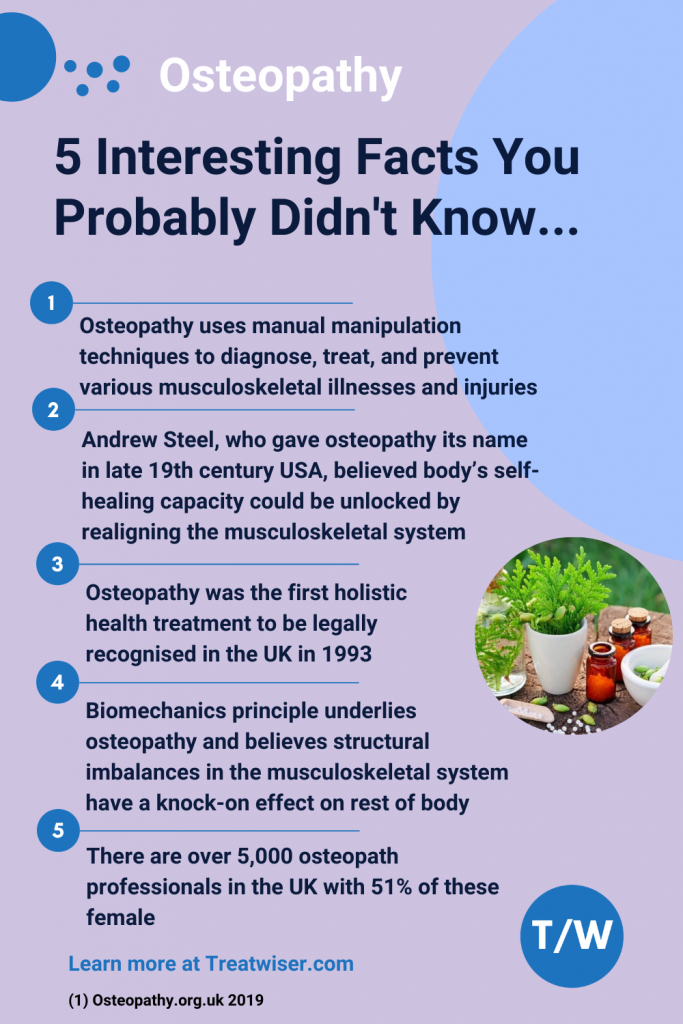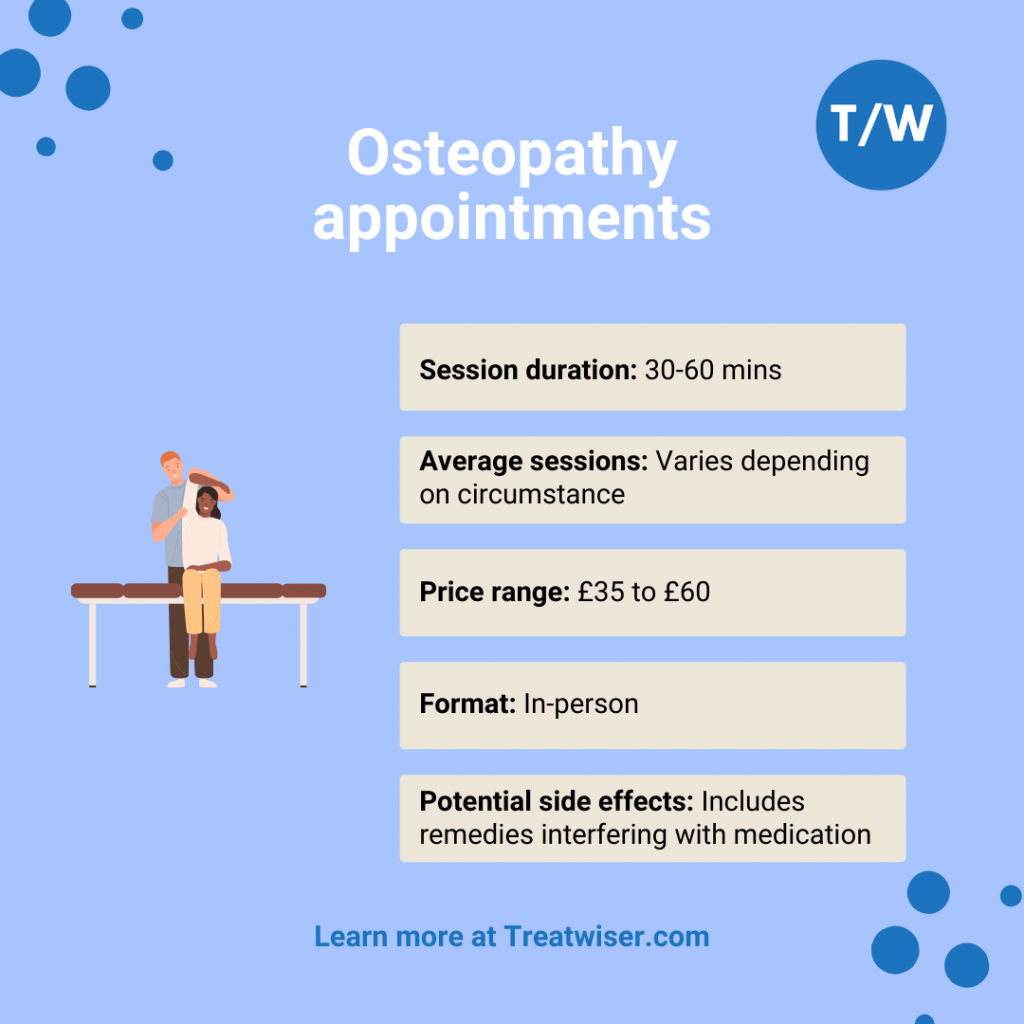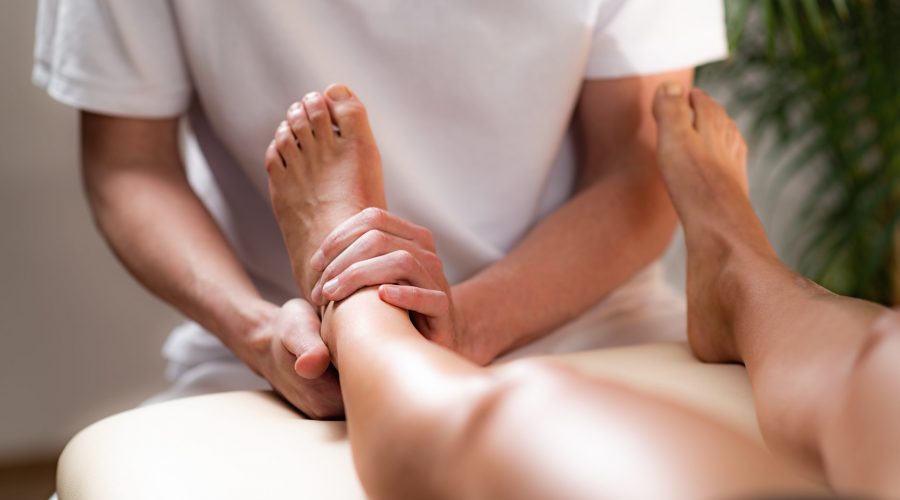Are you looking for relief from muscle pain, osteoarthritis, or sports injuries? Osteopathy treatment is a form of manipulative medicine that treats these symptoms (and many more) by addressing the causes.
In this article, we explore osteopathy and what you can expect from this all-natural therapy.
Table of contents
- 5 interesting facts about osteopathy
- What is osteopathy?
- What is the theory behind osteopathy?
- When and how is osteopathy used?
- What is the evidence to support osteopathy?
- What can I expect as an osteopathy patient?
5 interesting facts about osteopathy

What is osteopathy?
Osteopathy – or osteopathic medicine – is a non-invasive, hands-on therapy that uses manual manipulation techniques to diagnose, treat, and prevent various musculoskeletal illnesses and injuries.
Performed by a qualified practitioner, known as an osteopath or a doctor of osteopathy, the therapy restores balance to the musculoskeletal system by adjusting the joints, spine, muscles, tendons, and ligaments. In doing so, it may relieve pain, improve mobility, balance the nervous system, and stimulate blood and lymph flow.
The origins of osteopathy treatment
In 1874, an American physician named Andrew Taylor Still began researching ways to help his patients that treated the root cause of their ailments. He believed that the body’s self-healing capacity could be unlocked by realigning the musculoskeletal system – a practice he named Osteopathy.
Dr Still’s osteopathic practise soon gained popularity across America as patients found relief from their symptoms. In 1892, he opened the American School of Osteopathy. Almost a hundred years later, in 1993, osteopathy was the first holistic health treatment to be legally recognised in the United Kingdom.
What is the theory behind osteopathy?
Osteopathy treats the root cause of the problem
The frustrating thing about allopathic medicine is that it targets symptoms in isolation, which is why many people turn to osteopathy! Osteopathy looks for the underlying cause of the symptoms or injuries by assessing the entire body as well as looking at the patient’s lifestyle and stressors.
Osteopaths look for structural imbalances
Osteopathy is based on biomechanics, which believes underlying structural imbalances in the musculoskeletal system have a knock-on effect on the health of the rest of the body.
Osteopaths are trained to use their hands to gently palpate the body and look for imbalances and tension. By manipulating and realigning the bones, joints, and muscles, osteopathy helps the body heal.
When and how is osteopathy applied?
Osteopathy may support health and wellness by:
- Eliminating muscle tension and fatigue
- Increasing mobility
- Improving nerve health
- Encouraging a relaxation response
- Improving lymphatic flow
- Boosting circulation
Osteopathy treatment treats a variety of conditions
Patients commonly seek out osteopathy for the following reasons, however more research is required to support its efficacy in some instances, and you may wish to speak to your GP or qualified medical practitioner before booking any appointments:
- Arthritis
- Chronic pain
- Muscle spasms and fatigue
- Postural problems
- Sciatica
- Frozen shoulder
- Repetitive strain injuries
- Sports injuries
- Breathing problems
- Low immunity
- Allergies
- Headaches
- Fibromyalgia and Chronic Fatigue Syndrome
- Digestive complaints
- Insomnia
- Low mood and anxiety
Seeing an osteopath before you present with symptoms may also improve your overall wellness!
Osteopathy treatment is safe for babies and children
Osteopathy is a safe treatment for children. It’s ideal for realigning the spine after a natural birth. Interestingly, research has shown osteopathic manipulations may significantly reduce the length of time premature infants need to spend in the hospital (1).
Osteopathy treatment uses a range of techniques
Osteopathy techniques vary depending on the condition or person being treated.
Cranial versus structural osteopathy
Osteopaths use a combination of structural osteopathy – focusing on the body’s musculoskeletal system – and cranial osteopathy.
Some structural osteopathy techniques include:
- Spine and muscle manipulation
- Stretching
- Joint mobilisation
- Postural release
- Lymphatic drainage massage
- Myofascial release
- Joint articulation
- Soft tissue release
- Gentle abdominal manipulation
Cranial osteopathy involves gently manipulating the bones in the skull. This technique is so subtle that you may not even feel like you’re being worked on! However, it is incredibly powerful and often used on newborns as well as people suffering with headaches, and TMJ.
What is the evidence to support osteopathy treatment?
While there is limited high-quality evidence to support osteopathy, clinical studies have shown some promising results.
Lower Back Pain: Research shows osteopathy appears to be an effective treatment for lower back pain. A 2014 review of 15 studies found that osteopathic manipulative treatment significantly reduced acute and chronic back pain (2). It also provided relief from back pain in pregnant and post-partum women.
Neck Pain: Several studies have shown osteopathy is a clinically significant treatment for those with chronic neck pain (3).
Migraines: A 2015 study in the Journal of Complementary Therapies in Medicine found that osteopathy reduced the severity and duration of migraines (4).
Irritable Bowel Syndrome: Research shows that visceral osteopathy – gentle osteopathic manipulations on the abdominal area – may help to alleviate diarrhoea, abdominal distension, and abdominal pain in people with IBS (5).
What can I expect as an osteopathy patient?
An osteopathy appointment is nothing to be nervous about! Here’s what you can expect.
The osteopathy appointment
An osteopathy appointment typically lasts 30 minutes; however, the first consultation may take up to 60 minutes. At the start of your initial appointment, you’ll be asked about your medical history, lifestyle and exercise habits, and current symptoms.
Next, you’ll remove your shirt and be asked to perform certain movements or stretches so your posture, spine, and mobility can be assessed. You’ll then lie on a therapy table as the therapist / practitioner uses their hands to palpate, stretch, and manipulate your spine, joints, and muscles. This is intended to identify and correct imbalances and misalignments. Your comfort always comes first and the therapist / practitioner will check in with you throughout the appointment.
At the end of the first session, a diagnosis and treatment plan will be discussed. Your osteopath may also suggest certain lifestyle changes, self-massage techniques, postural corrections, and muscle strengthening exercises for you to perform at home.

How do I find an osteopathic practitioner and what qualifications should they have?
In the UK, osteopathic doctors are required to finish a 4 to 5-year honours degree accredited by the General Osteopathic Council (GOsC) to practice legally. This includes thousands of hours of theoretical, practical, and clinical training.
You can find an osteopath in your area by searching the GOsC register here or asking your primary care physician for a recommendation.
You can also use Treatwiser’s directory to find an osteopath near you. Use the search features to narrow your search by location, professional body membership status, and more.
How much will it cost?
In the UK, osteopathic treatments are available on the NHS. However, you have to be referred by a GP, and the number of treatments is limited. This means people often choose to pay for sessions privately. If you’re paying out of pocket, the cost ranges from £35 to £60.
How many appointments will I need and over what period?
Most people will need 3-6 sessions to see an improvement. After the initial treatment protocol, therapists / practitioners usually recommend attending maintenance sessions every 6-8 weeks to keep your body in good shape.
Do osteopathic treatments hurt?
Osteopathy is not intended to be painful. If you have an injury, muscle spasm, or an area of swelling, the treatment will be adjusted to cause you minimal discomfort.
What are the risks associated with osteopathy treatment?
Osteopathy is considered safe when performed by a licensed osteopath. However, you may experience minor fatigue, headaches, and stiffness following manual manipulation. These symptoms should resolve quickly, but contact your therapist / practitioner if they persist.
If you have a bone fracture, severe osteoporosis, a blood clotting disorder, or active infection, please speak to your doctor before starting osteopathic treatment.
Resources and further osteopathy therapy information
- https://pubmed.ncbi.nlm.nih.gov/25974071/
- https://pubmed.ncbi.nlm.nih.gov/25175885/
- https://www.journalofosteopathicmedicine.com/article/S1746-0689(15)00049-8/fulltext
- https://pubmed.ncbi.nlm.nih.gov/25847552/
- https://pubmed.ncbi.nlm.nih.gov/23981319/
DISCLAIMER: The Site cannot and does not contain medical / health advice. The medical / health information is provided for general informational and educational purposes only and is not a substitute for professional advice. Accordingly, before seeking any form of medical advice, diagnoses or treatment based upon such information, we encourage you to consult with your GP or other qualified health practitioner. You must never disregard professional medical advice or delay in seeking it because of something mentioned on this Site. The use or reliance of any information contained on the Site is solely at your own risk.




